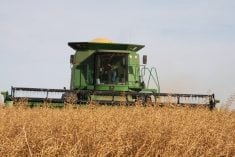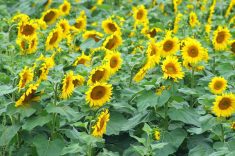Of all the things shared by Prairie farmers on both sides of the Canada-U.S. border, an abiding love of their land, fretting over the weather and a no-nonsense, ‘get ‘er done’ attitude are among those that come to mind.
Unfortunately, this also includes weed problems.
Weeds know no borders, of course, so when weed trouble or a resistance issue surfaces on the northern U.S. Plains, there’s a decent chance of it turning up somewhere on Canadian cropland sooner or later.
“Folks in Manitoba and Saskatchewan will often look south, and we also often look north for the problems our neighbours on the borders are experiencing, because it’s kind of a good indicator of what might be the next weed challenge problem,” says Joe Ikley, an extension weed specialist with North Dakota State University.
Read Also

Cancer agency reclassifies another herbicide ‘probably carcinogenic’
The WHO’s cancer research agency has now put atrazine, a herbicide well known to corn growers, in the same potential-hazard category where the agency put glyphosate.
Grainews interviewed Ikley after he ventured north in February to speak to Canadian farmers attending the CropConnect 2024 conference in Winnipeg. He cautioned them about three particularly problematic weeds in North Dakota: kochia, waterhemp and Palmer amaranth.
Kochia
U.S. and Canadian crop producers alike have had to deal with kochia for many years. Ikley notes the pernicious tumbleweed has been tumbling around farms in the northern Great Plains states and on the Canadian Prairies for more than 100 years, and it is now found in every corner of North Dakota.
“Where it becomes a very big problem for us in modern row-crop production is herbicide resistance,” he says.
“This is one of the first weeds in North Dakota that was documented to develop resistance, really starting with the herbicide 2,4-D probably 40 or 50 years ago. Since then, new chemistries have come along, and there just seems to be a small lag between an introduction of a chemistry and some resistance being found in kochia if that chemical is used on a wide scale,” Ikley adds.
“For a new chemical introduction in small grains that might be used on eight million acres, for instance, it doesn’t take too long to find kochia resistance to that type of product.”
In North Dakota, there are kochia populations resistant to Groups 2, 4, 5 and 9 herbicides, and a new type of resistance has just turned up that spells trouble for crop producers.
That new issue, Group 14 resistance, is serious since two Group 14 herbicides, saflufenacil and carfentrazone, are frequently used by North Dakota farmers as a burndown tool on their no till acres.
“The group 14 resistance is new for us. 2021 to 2022 is when we first heard a lot of complaints about it and then confirmed this type of resistance,” Ikley says.
“This is very important … because we’ve relied on some of these products to control kochia,” he adds. “For decades we relied on glyphosate, and it was very effective ahead of planting crops, but with glyphosate resistance, that’s not an option.
“Now all of a sudden, (the Group 14 herbicides) are tools are out of our toolbox with these new resistant populations, which then leaves few effective herbicides we can use in that burndown or pre-seed type of application.”
In his home state, Ikley says, farmers have an easier time managing kochia in corn and small grains. “That’s because the herbicide chemistry in those crops has remained relatively effective on our kochia populations.”
He notes there are fewer control options in broadleaf crops, especially soybeans, in North Dakota.
“Soybeans are less competitive early in the season, and that’s where kochia can really thrive if we have resistance to soybean chemistry,” says Ikley. “Certainly, we can see up to 50 per cent yield loss in a soybean crop from a competitive kochia population.”

Waterhemp
Waterhemp is a type of pigweed first identified in North Dakota’s Red River Valley in the 1990s. Ikley says in the late 2000s and early 2010s, it started to become major problem in the southeastern part of the state.
“It’s now the dominant weed in that southeast corner,” he says. “It has spread and can now be found in basically every county in the eastern half of the state.”
Ikley notes waterhemp is showing up more frequently in three counties right next to the Canadian border, which is cause for concern for Manitoba farmers.
“Prior to 2023, we might find a handful of plants in some fields in those counties. This past year, we had a few fields with five- or 10-acre patches of very dense waterhemp infestations,” says Ikley.
Waterhemp was first detected in Manitoba in 2019 and is classified as a noxious weed requiring rigorous control measures. According to Manitoba Agriculture, there were 19 rural municipalities with fields where waterhemp was detected in 2023, most of them in the southeastern corner of the province.
Waterhemp in North Dakota is most problematic in sugar beets, soybean, and dry edible beans. “Those are some of our crops that have limited effective herbicide options and are relatively slow to grow and develop in the spring,” Ikley says.
Ikley notes he’s seen serious waterhemp infestations in soybean crops result in yield losses of up to 75 per cent.
One of the reasons for waterhemp’s spread in North Dakota is rising herbicide resistance. According to Ikley, you’ll find resistance to Groups 2 and 9 in pretty much every waterhemp population in the state, and there’s also Group 4 resistance farmers must contend with.
And just like their kochia counterparts, North Dakota’s waterhemp populations are also developing resistance to Group 14 herbicides.
Ikley says that’s a serious concern in soybean and dry beans, since the Group 14 herbicides are commonly used for both pre-emergence and post-emergence weed treatments in those crops.
Ikley maintains escapes of Group 14-resistant waterhemp from pre-emergence applications are a major concern for season-long weed management. Fortunately for North Dakota soybean producers, he says, they still have some post-emergence options for cleaning up these escapes.

Palmer amaranth
Palmer amaranth is another pigweed species that Ikley says was first detected in 2018 in North Dakota. Since then, it has been found in fields in 19 counties in the state.
The first case of Palmer amaranth in a Manitoba field was in 2021. As of the 2023 crop season, identification of the weed was limited to a single rural municipality, Dufferin.
According to the Manitoba Crop Alliance, neither waterhemp nor Palmer amaranth, which is also classified as a noxious weed in Manitoba, has yet been detected in Saskatchewan and Alberta.
Ikley says to date, Palmer amaranth infestations in North Dakota haven’t been as serious as they have been with waterhemp.
“We’re on high alert for infestations,” he says. “We’ve raised a lot of awareness on Palmer amaranth in hopes of finding infestations when they’re early and removing them, and that has been effective. … For the majority of infestations, I would say, we have been able to keep them under control.”
Ikley maintains the best way to stop the spread of waterhemp, as well as Palmer amaranth, is with pre-emergence or pre-seed herbicides. That’s because the weeds are so much more difficult to control once they’re out of the ground.
Like waterhemp, Palmer amaranth can evolve herbicide resistance quickly. In North Dakota, the resistance list for this weed now includes Groups 2, 4, 5, 9 and 27 herbicides.
Ikley has conducted research into the kinds of herbicides North Dakota farmers could still count on for Palmer amaranth protection across a broad range of crops. Glufosinate, a Group 10 herbicide, was one; the other, perhaps surprisingly, was Group 14 herbicides.
Prolific seed producers
Both Palmer amaranth and waterhemp can growly very quickly — up to two to three inches a day in optimal conditions -— and they’re also prolific seed producers, which enables them to quickly take over fields if the plants aren’t effectively controlled.
When there’s direct competition with crops, these weeds can produce up to 100,000 seeds per female plant. But that number swells to more than one million when there is no competition.
Palmer amaranth and waterhemp, like all pigweed species, have small seeds, which enable them to be easily transported to new areas through contaminated straw, hay and other animal feed.
Farm equipment like combines can also carry the weed seed a long way. Contaminated cover crop seed and migratory birds can contribute to the spread of Palmer amaranth and waterhemp as well.
















